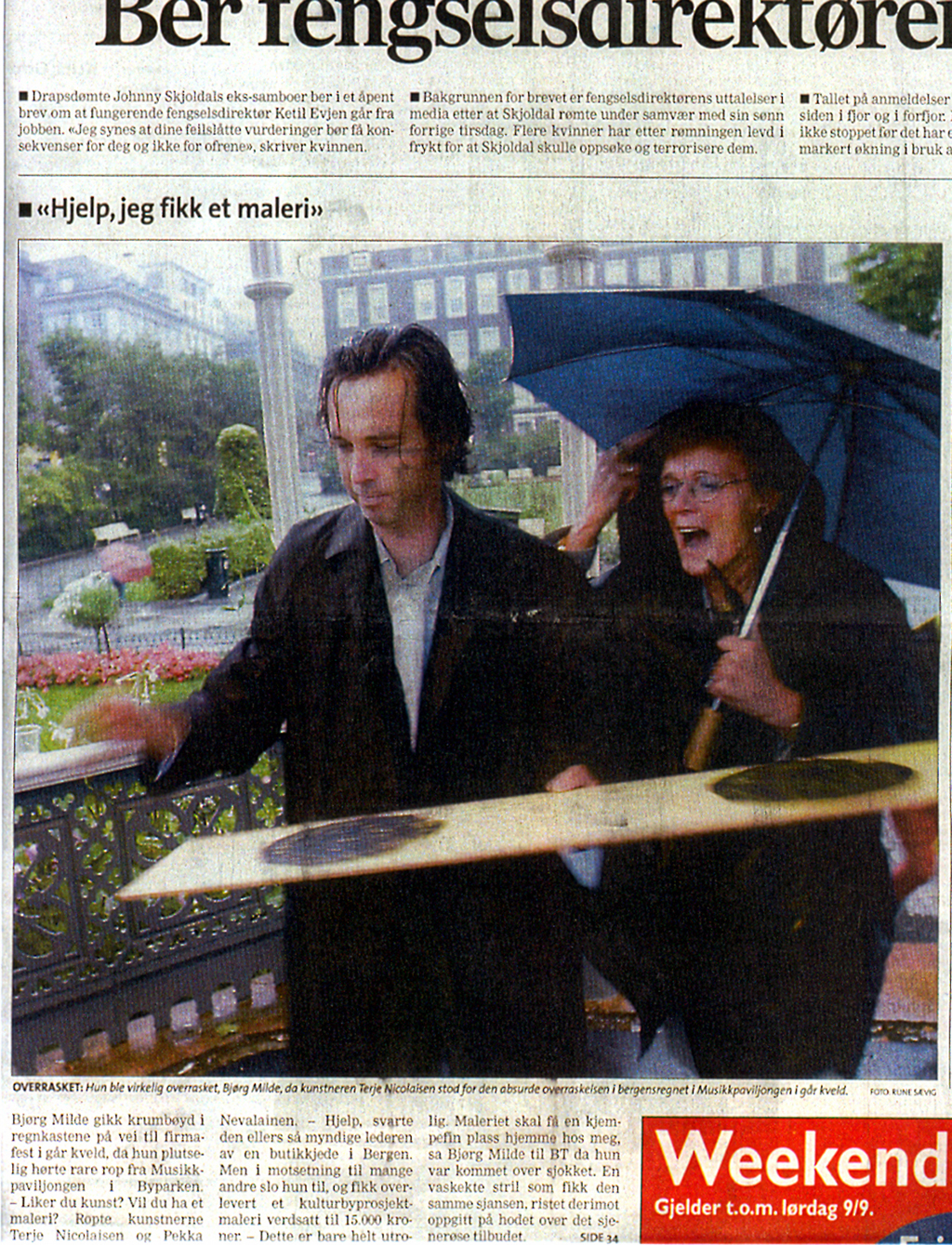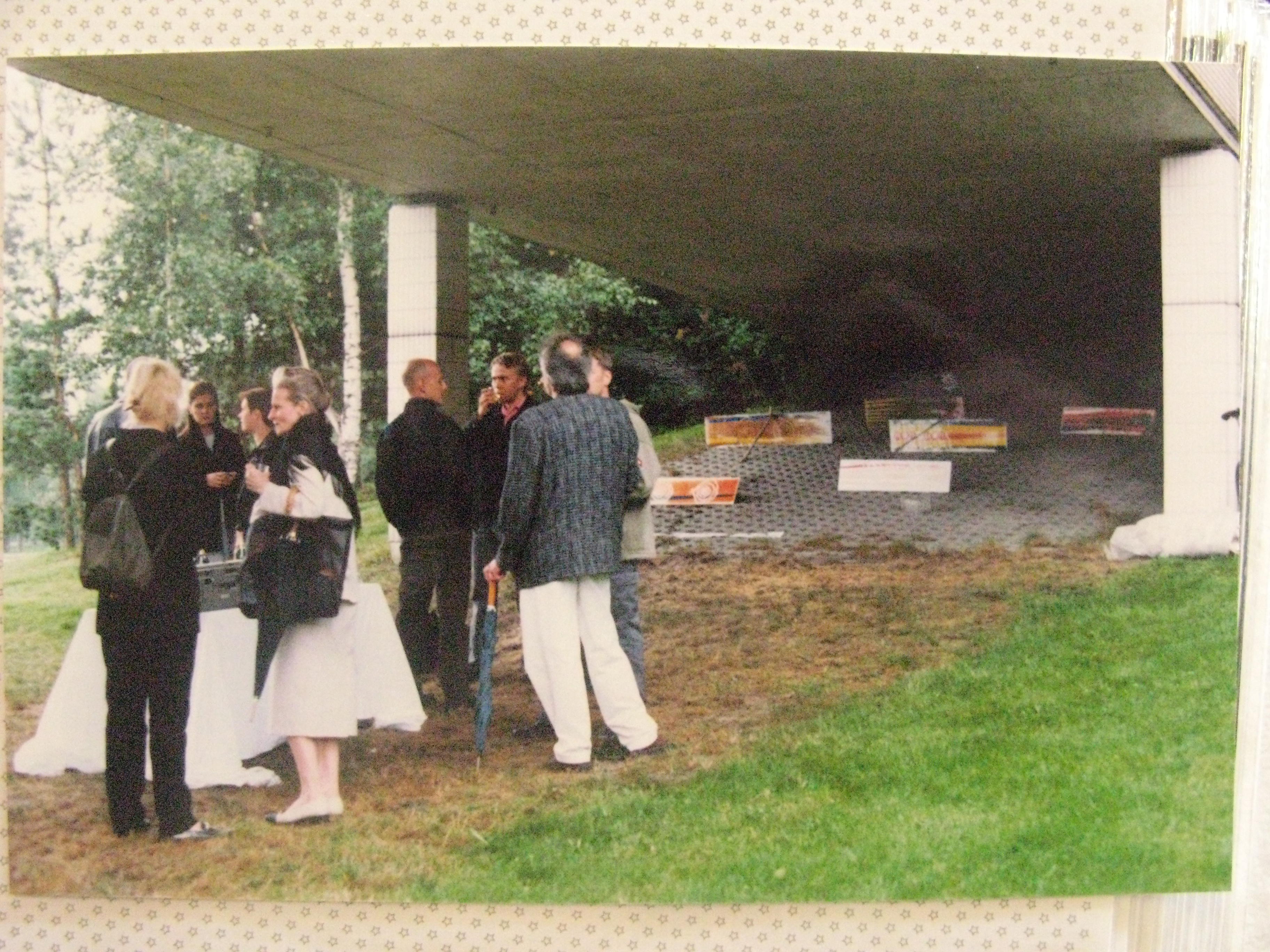with Pekka Nevalainen
Bergen / Helsinki 2000
"Help! Someone gave me a painting!"
Bypasser to Pekkaterje performance
Juha Van Ingen found us.
Together with Pekka Nevalainen I installed two temporary public art projects both in Bergen and in Helsinki;
50% LYKKE / 50% Happiness / 50% ONNI was a flowerbed with written text
Pekkaterje give-away painting sessions, we actually gave away paintings that we had made together
See the video here
and HERE
Giving The Debate Away
Grethe Melbye
More than other human habitats, a city is a place of discoveries and surprises, whether pleasant and or unpleasant. It is a place where it is likely that you see things today that you did not see yesterday, and encounter people who are not like yourself.
Not exactly being the urban swirl, Bergen celebrated itself as part of the European community as a Cultural City in year 2000. A lot of artists came rushing in to be part of the official program. They provided impulses different from mainstream media. The question is how much difference it made.
Having the lowest budget of all the nine cities most of the artists got badly paid. Still they contributed. This has often troubled me as a culture administrator and a student of mediaton, and my question has often been: Why bother so much trouble? The countercurrent activities of artists often end up like small comments explicit for the ones looking for it. When it becomes a public affair, the media mostly have a finger in the pie. These are providers of what Benedict Anderson would call imagined communities constructing our sense of reality. The media is the architect of a room where space and time is the material, and part of our social organisation.
While some people accused the Bergen2000 administrators of lacking focus, others would stress the positive implications of diversity. This was due to debates on the role of the nation state and the regional disrticts, but also to a debate on mass events versus small dispersed events. To the Bergen 2000 it was a question of their identity. Their task was to focus on branding Bergen in a local, regional, national and European context and at the same time, address both high and low culture. In other words, one was asking for three Kindereggs in one.
Within this framework the artists Terje Nicolaisen and Pekka Nevalainen had to realise their projects, initiated by Juha van Ingen. Both projects took place in the public space. They had the text 50%LYKKE written in a bed of flower and PEKKATERJE gave paintings away from free. These two projects can illustrate two different ways of communicating and organising social behaviour. While the PEKKATERJE event created or maybe just fortified a network of social relations, the 50%LYKKE sculptor was more open for anyone to participate in an ongoing debate.
In the PEKKATERJE project, the artists had to ask themselves for reasons to give a painting away and the receivers to question why they were given the honour. The non-receivers would ask themselves why not. In that way it became more dangerous to take part. The give away had similarities to the including/excluding project like the lucky/unlucky project in Espoo. But it also differed in the sense that there were no central distribution including all the citizens. In this sense it was using other forces of power. Nobody asked for the coin just as nobody asks for junk mail. But everybody was included in the happening. In the give away it was a matter of free will. At the same time, those who did not understand the benefits of coming to such an event, might miss something. Vital information might have been given away, who really knew what those paintings were?
The other project, 50% LYKKE were more like a statement in public. An anonymous voice speaking to the masses from the grass lawns encircling the artificial lake in the centre of the town. This biological billboard addressed the people passing by but did not explicitly give them any valuation of status. It was more open for interpretation and astonishment among the spectators that could, if they felt like it, bring something relevant up for discussion with fellow citizens. At the same time it was an annexation by the artists. There was less space for slacking off at the grass lawns, and people had to relate to just another message instead of having the interval for resting the eyes at the usual green grass.
On Tursday september 9th 2000, people could get the paintings. The pictures were offered while people made haste with passing the precious city-pavilion. Competing with the Bergen2000 opening event at the common a few blocks away, with brass music and dancers from the tango festival, the happening got bad conditions if the aim was to gain attention.
Who should get the paintings and by what presuppositions were not settled. I have no idea on what ground rules the artists made their choices and neither they did, they argued. It seemed that they gave away by immediate intuition. But in my view such things do not come by chance. Our preferences are more structured than we would believe, even when we want to fight conscious and deliberate actions. Who's getting and who isn't is a result of giving and gaining. One could say that while the artists were getting economic capital from Bergen, what the artists provided was symbolic capital, making it true that Bergen is a city of arts and culture. The give away gave more room for such forces taking place. It had an unplanned angle, but was the circumstance accidental?
The pictures were given to some of the persons that were there. They were mostly friends. I also got one, as being one of representatives of the Bergen2000. As a person with the ambition to travel light in life, I gave it to my colleague Guro. I believed she deserved a present to brighten up her drudgery work at the office. To me it was the act of giving that came to be important. And that I was one of the chosen ones. To me, the painting itself was just the mediator of generous attitude, and I passed this attitude on. But I did not pass it on to my boss. I passed it on to a colleague. In that way I used this piece of work to make a statement.
Giving a painting away is a statement. In our culture, paintings are sold and the more people want to pay for it, the more fuzz about it. Artists that are unable to make fuzz about themselves will not get so many opportunities. That means money. Neglecting economy might be one interpretation of the give away. At the same time, it illustrated that also gift economies have their power structures.
Another restriction was the media attention. Without journalist writing about the event this happening could have been a very internal affair. If the people present at the give away were the only one to see the single lady fighting her way through the cats and dogs weather wanting a painting for free, the event would have lost value. But the news came about to the subscribers to the biggest newspaper in Bergen. With the attention from the
press it became a public affair. It was documented. It was not a cock-and-bull story among artists and art administrators. It became true and real as it entered the imagined Bergen community sharing the same columns every morning at their breakfast table.
With 50% LYKKE there were no doubt about its existence. It did not get too much press coverage, but it would not need that. For a whole summer the citizens of Bergen could enjoy the letters 50%LYKKE written with flowers on the grass lawns encircling the artificial lake in the centre of the town. Was it the municipal gardener that wanted to say something?
In this area the art museums are to be found in a row. Several art projects have taken the lake Lille Lungegaardsvann and the grass lawns into use. The bed of flowers was so big that the letters were readable from the top of the mountain at Floeyen, a must for every tourist visiting Bergen. The placing of the letters could be read like an extension of the art galleries - maybe like a commercial for an exhibition taking place in one of them.
For the citizens of Bergen, used to have a high frequency of performances and installations in public space, it would be no doubt that this was "art". They might of course discuss whether it was so.
It was not. It was a biological billboard promoting a most uncertain message. The text did not have a subject demanding something from the audience, as in Jenny Holtzers truism PROTECT ME FROM WHAT I WANT or making an assertion as in MONEY CREATES TASTE. It was like a slogan but it was not created as a moralising lecture. 50%HAPPYNESS. It looked more like a bargain offer. But was what for sale? Happiness? Can you buy that? This bed of flower could not be given away or sold like the paintings. It was public in municipal space. It was to be shared with anyone. Instead of creating a network of people giving each other gifts, it made a reference point for "the masses". It opened up for discussions about happiness. Is it possible to be happy through neck and crop? Or do we have to accept that nobody is entirely happy. Do we want to be happy 100%? Maybe 50% will do? Do someone want to tell us something?
Whatever that was told, was told together with a multitude of other messages. Ads for various products, flyers about some political organisation, text in newspapers and music played in the shopping centres; or as on Thursday night September 9th, paintings given away for free. Among all other messages this was just one of them. If it made any difference is hard to say. An if it did, how did that take place? In his book MaoII the
writer Don DeLillo makes a suggestion: "All the impulses of all the media were fed into the circuitry of my dreams. One thinks of echoes. One thinks of an image made in the image and likeness of images. It was that complex."
When speaking to people about the grass lawn this felt more true than ever. Most of them misunderstood and believed I referred to a Norwegian sitcom launched in the same period named CA.LYKKELIG. (ca.happy) The funny part was that the two words had merged. They said CA LYKKE. In this way it was constrained by a media corporate with a better instrument for distribution of messages than a grass lawn. On the other hand, the grass lawn had had an effect. It made a difference. A small one. It opened up for a debate. In my
experience a debate on what the real name of that sitcom really was, and after one had established the name, one discussed why Norwegian sitcoms could not compete with the American ones, like Friends.
So why bother? Giving people something to talk about is by all means important. Where we direct our focus and how our attention is managed is always of importance to us. These two projects gave their questions away. There were no explicit statements, no intentional makings of message like in an advertising agency. In this respect the ambiguity opened up for reflections on the means of speaking, and not on what is spoken.





